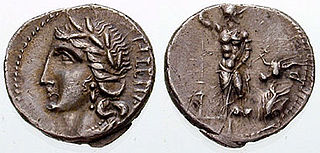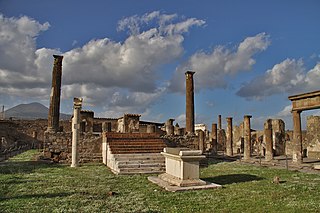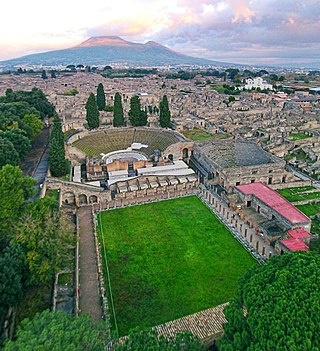
Oscan is an extinct Indo-European language of southern Italy. The language is in the Osco-Umbrian or Sabellic branch of the Italic languages. Oscan is therefore a close relative of Umbrian.

The pyramid of Cestius is a Roman Era pyramid in Rome, Italy, near the Porta San Paolo and the Protestant Cemetery. It was built as a tomb for Gaius Cestius, a member of the Epulones religious corporation. It stands at a fork between two ancient roads, the Via Ostiensis and another road that ran west to the Tiber along the approximate line of the modern Via Marmorata. Due to its incorporation into the city's fortifications, it is today one of the best-preserved ancient buildings in Rome.

The Theatre (UK) or Theater (US) of Pompey, also known by other names, was a structure in Ancient Rome built during the latter part of the Roman Republican era by Pompey the Great. Completed in 55 BC, it was the first permanent theatre to be built in Rome. Its ruins are located at Largo di Torre Argentina.

The Aqua Augusta, or Serino Aqueduct, was one of the largest, most complex and costliest aqueduct systems in the Roman world; it supplied water to at least eight ancient cities in the Bay of Naples including Pompeii and Herculaneum. This aqueduct was unlike any other of its time, being a regional network rather than being focused on one urban centre.

Spolia are stones taken from an old structure and repurposed for new construction or decorative purposes. It is the result of an ancient and widespread practice (spoliation) whereby stone that has been quarried, cut and used in a built structure is carried away to be used elsewhere. The practice is of particular interest to historians, archaeologists and architectural historians since the gravestones, monuments and architectural fragments of antiquity are frequently found embedded in structures built centuries or millennia later. The archaeologist Philip A. Barker gives the example of a late Roman period tombstone from Wroxeter that could be seen to have been cut down and undergone weathering while it was in use as part of an exterior wall and, possibly as late as the 5th century, reinscribed for reuse as a tombstone.

The Augustus of Prima Porta is a full-length portrait statue of Augustus Caesar, the first emperor of the Roman Empire.

The Temple of Apollo Palatinus, sometimes called the Temple of Actian Apollo, was a temple of the god Apollo in Rome, constructed on the Palatine Hill on the initiative of Augustus between 36 and 28 BCE. It was the first temple to Apollo within the city's ceremonial boundaries, and the second of four temples constructed by Augustus. According to tradition, the site for the temple was chosen when it was struck by lightning, which was interpreted as a divine portent. Augustan writers situated the temple next to Augustus's personal residence, which has been controversially identified as the structure known as the domus Augusti.

The House of Julia Felix, also referred to as the praedia of Julia Felix, is a large Roman property on the Via dell'Abbondanza in the city of Pompeii. It was originally the residence of Julia Felix, who converted portions of it to apartments available for rent and other parts for public use after the major earthquake in 62 AD, a precursor to the eruption of Mount Vesuvius in 79 AD that destroyed Pompeii.

The Suburban Baths are a building in Pompeii, Italy, a town in the Italian region of Campania that was buried by the eruption of Mount Vesuvius in 79 AD, which consequently preserved it.

The Temple of Apollo, also known as the Sanctuary of Apollo, is a Roman temple built in 120 BC and dedicated to the Greek and Roman god Apollo in the ancient Roman town of Pompeii, southern Italy. The sanctuary was a public space influenced by Roman colonists to be dedicated to Greco-Roman religion and culture.

Roman portraiture was one of the most significant periods in the development of portrait art. The surviving portraits of individuals are almost entirely sculptures, covering a period of almost five centuries. Roman portraiture is characterised by unusual realism and the desire to convey images of nature in the high quality style often seen in ancient Roman art. Some busts even seem to show clinical signs. Several images and statues made in marble and bronze have survived in small numbers. Roman funerary art includes many portraits such as married couple funerary reliefs, which were most often made for wealthy freedmen rather than the patrician elite.

Pompeii was an ancient city located in what is now the comune of Pompei near Naples in the Campania region of Italy. Pompeii, along with Herculaneum and many villas in the surrounding area, was buried under 4 to 6 m of volcanic ash and pumice in the eruption of Mount Vesuvius in 79 AD.
On 5 February AD 62, an earthquake of an estimated magnitude of between 5 and 6 and a maximum intensity of IX or X on the Mercalli scale struck the towns of Pompeii and Herculaneum, severely damaging them. The earthquake may have been a precursor to the eruption of Mount Vesuvius in AD 79, which destroyed the same two towns. The contemporary philosopher and dramatist Seneca the Younger wrote an account of the earthquake in the sixth book of his Naturales quaestiones, entitled De Terrae Motu.
Alison E. Cooley is a British classicist specialising in Latin epigraphy. She is a professor at the University of Warwick and former head of its Department of Classics and Ancient History. In 2004, she was awarded The Butterworth Memorial Teaching Award.
Publius Marius P. f. was a Roman senator and ordinary consul in 62 AD with Lucius Afinius Gallus as his colleague. Although Frontinus records that Marius was appointed curator aquarum in 64, we know nothing more about him.

The Boscoreale Treasure is a large collection of exquisite silver and gold Roman objects discovered in the ruins of the ancient Villa della Pisanella at Boscoreale, near Pompeii, southern Italy. Consisting of over a hundred pieces of silverware, as well as gold coins and jewellery, it is now mostly kept at the Louvre Museum in Paris, although parts of the treasure can also be found at the British Museum.
Gaius Ummidius Actius Anicetus was a Roman pantomime actor who lived in Pompeii.

The gens Norbana was a plebeian family at ancient Rome. Members of this gens are first mentioned toward the beginning of the first century BC, and from then to the end of the second century AD they filled a number of magistracies and other important posts, first in the late Republic, and subsequently under the emperors.

Freedmen in ancient Rome existed as a distinct social class (liberti), with former slaves granted freedom and rights through the legal process of manumission. The Roman practice of slavery utilized slaves for both production and domestic labour, overseen by their wealthy masters. Urban and domestic slaves especially could achieve high levels of education, acting as agents and representatives of their masters' affairs and finances. Within Roman law there was a set of practices for freeing trusted slaves, granting them a limited form of Roman citizenship or Latin rights. These freed slaves were known in Latin as liberti (freedmen), and formed a class set apart from freeborn Romans. While freedmen were barred from some forms of social mobility in Roman society, many achieved high levels of wealth and status. Liberti were an important part of the "most economically active and innovative entrepreneurial class" in the Roman Empire. The legal and social status of freedmen remained a point of cultural and legal contention throughout the Republic and Empire.















